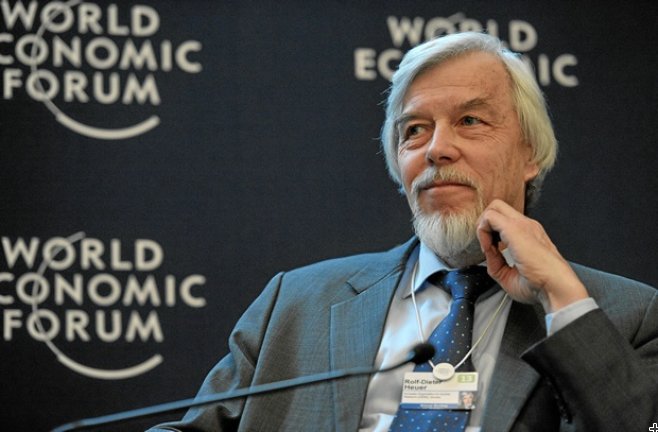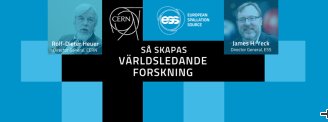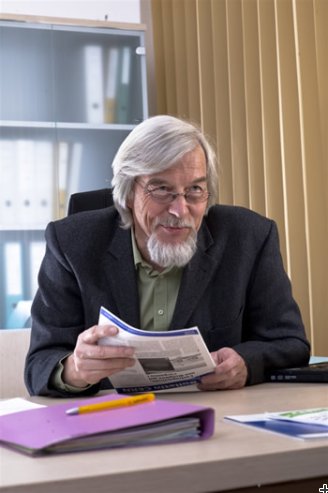Copyright 2012 neutronsources.org | All rights reserved. | Powered by FRM II | Imprint / Privacy Policy
Director General of CERN talks with ESS in Advance of Almedalen Workshop
Date: 25/06/2015
Source: http://europeanspallationsource.se
ESS and CERN. Prof. Rolf-Dieter Heuer, Director General at CERN since 2009, took some time to speak with ESS about the two facilities. Next week, Heuer will be participating in the ESS event "To Create World-Leading Research" at the annual Swedish political forum known as Almedalen.
LUND and MEYRIN — On Monday, June 29, the European Spallation Source (ESS) will host a workshop at Almedalen, the weeklong Swedish political festival held in Visby, on the island of Gotland. The event is considered the most important political forum in Sweden, and has been held each year for several decades. The ESS workshop will feature Heuer along with ESS Director General and CEO Jim Yeck, ESS Steering Committee Chair Lars Börjesson, Swedish State Secretary for the Ministry of Education and Research Anders Lönn, Deputy CEO of Skanska Sweden AB Håkan Stenström, and other management personnel from Skanska Sweden, the consulting firm PwC, and Vinnova.
To Create World-Leading Research will focus on the practical challenges of building an integrated social, science, and business community around the nexus of large research infrastructures like ESS and CERN. In the interview below, Heuer reflects on the similarities and differences in the challenges that CERN has faced and those anticipated at ESS, the world’s next-generation neutron science facility currently under construction in Lund, Sweden.
Prof. Heuer, 67, is a German physicist who, prior to being named Director General of CERN, spent several years as Research Director at the German Electron Synchrotron, DESY, in Hamburg. He has been awarded both the Niels Bohr Medal and the Edison Volta Prize.
ESS:
ESS is under construction, with demands to move effectively on cost and schedule in order to generate its first neutrons in 2019 and to begin a user program by 2023. What advice do you have to this European project? And what are the markers of success?
Heuer:
Like in every project, keep a very close eye on the spending profile, build up a parallel capacity, and build up an exciting experimental programme. Keep people involved. That means not only the scientists but also the people living in the region where ESS is being built. I think what is important in order for the success of the facility, in making ESS a fantastic facility, is that you have the positive spirit as a support from the society around the facility. People in the region can become some of ESS’ greatest ambassadors. It’s easy for scientists to be an ambassador of a good facility, but you need also the surrounding population in this. Be very open. Maintain an open style of leadership involving the population. This is how the success of a facility is made, and of course the excitement of science. ESS should always keep in mind that ESS is not a stand-alone facility. ESS, like CERN and other facilities, like everybody essentially, is part of society. I think this is something we have to promote. We have to be open, we have to be accessible, and we have to integrate into society. We have to show society that we are there for society and not only a playground for scientists.
ESS:
I read that CERN was built after World War II in an effort to minimise the brain drain out of Europe into the US. Today we have strong economic and societal progress also in Asia. What’s your view on Europe’s position when it comes to research and innovation politics today?
Heuer:
I feel that the difference between Europe being a very well developed continent and other regions that are at the moment emerging is that in the developed countries the interest in advanced science seems like a too-difficult effort. People seem to feel that they have everything. They don’t have the same desire or hunger for research, science and education as people have in the emerging economies where they see this as a possibility to move up. If we are not vigilant enough in Europe, this balance between a well developed Europe and the emerging economies will shift. I understand that for pragmatic reasons politicians have to have short-term goals, but the good politicians must at the same time have long-term vision. For our future, we have to attract more people into science and technology. If we are not able to do that, the future lies outside Europe. Here, ESS can also play a strong role by being a beacon for science in society.
ESS:
In only a few years, the staff at ESS has increased from 10 people to several hundred employees coming from 42 different nations. It feels like a peace project…
Heuer:
Exactly! When CERN was founded in 1954, this discussion started already in 1949, and it was obvious that it happened along this slogan “science for peace”. There is one language that everybody can speak and that’s science. Use the language of science to try to better understand the other nations and people. You break the wall so to speak between cultures. In 1949, shortly after the World War, to bring to the same table the countries who were before fighting each other is a major success. In that tradition CERN continues, and in this condition ESS starts.
ESS:
ESS and CERN collaborate in the development of accelerator technology for ESS. How can the construction and operation of the world’s next-generation neutron science facility contribute back to CERN?
Heuer:
You see, I think that everything that we are doing, we cannot do alone. We need collaborators, we need universities, we need other institutes where forefront technology is designed and tested. So I think the flow back to CERN is through the people who are trained in a, for us, relevant technology or in working with such projects. Some of them are later coming back to CERN, some of them stay with their new project, and some of them go elsewhere. It is this educational and training aspect—when you develop something for ESS, something which is not of immediate use for CERN, but could well be of use in the near- or medium-term future—that will then come back to us. For this reason, it is absolutely vital to have these collaborations. The experts who serve the ESS project at the moment will after that be serving other institutes, including CERN. It’s very important to share. If you have expertise at CERN which can be used at ESS, why not share that. Then ESS will be sharing back to CERN. After all, what we want to do is science.
ESS:
ESS is now transitioning to the new legal framework of a European Research Infrastructure Consortium, an ERIC, which is a legal framework of the European Commission still finding its form and where ESS can contribute to improve the politics and administration of research infrastructures and multilateral collaboration. Do you have any advice or pressing matters that you would like ESS to address in this context?
Heuer:
Well, I have an easy way out of this and that is the CERN convention. The CERN convention was written down more than 60 years ago and it has stood the test of time. I haven’t looked very closely into the framework of the ERIC, but what I find with the CERN convention is that it defines the necessary but not more. So it doesn’t bureaucratise things tremendously. You can adjust your governance to some extent over the course of the years and since the whole world is evolving you need to adjust from time to time. What I like with our convention is the easiness and the clarity and effect that it doesn’t nail down everything to the last comma or the last stop. I would doubt that you could do that again in these times, to have such a relatively flexible convention. It has worked in such a way that we have an ever-increasing membership and we are flexible enough to accommodate associate members, etc. There’s a lot of flexibility in this governance model. So for me, the CERN convention is the best example.
"ESS should always keep in mind that ESS is not a stand-alone facility. ESS, like CERN and other facilities, like everybody essentially, is part of society."
ESS:
So projects need flexibility on one hand, but on the other, stakeholders investing in large expensive projects want to minimise risk and tend to require almost everything not only fully planned to the last detail, but almost having the entire project delivered and realised before they dare to invest?
Heuer:
Exactly, that’s what I mean. Today, governance models are setting boundary conditions too tightly. My advice is to try to convince people that they should have more flexible boundary conditions. If you have a too rigid framework, you will have a problem particularly for research. A rigid framework might be useful for certain sectors, certain enterprises, but for research you definitely need some flexibility. I mean, what do you need? You need rigid conditions concerning things like procurement, finance, legal administration, etc., because you have to be absolutely free of conflict of interest. But what concerns directions, moving for example material resources into personnel, or human competence into material resources, there I think the management team and the project leaders have to have enough freedom to adjust according to the changing needs of a project. I mean, it’s the first ESS that you are building! You need this flexibility. This is something that I think is sometimes ignored by administrators.
ESS:
After the success with the construction of the Large Hadron Collider (LHC) and validating the theory of the Higgs boson, what is CERN’s current mission? What are your challenges right now?
Heuer:
We have restarted the LHC for higher energy. This means you can study the Higgs boson in more detail. You have to learn the behaviour of that particle, you have to investigate it in much more detail in order to learn about its true nature, its true behaviour, because the Higgs boson completes just five percent of the knowledge of our Universe. That is the five percent of our visible Universe, and any deviation in the property of the Higgs boson in the expectation of the visible world could tell us something about the dark Universe, the dark matter, the dark energy. So, we have a program for 20 years to study this particle. In addition, LHC could now with the higher energy also maybe open a window into discovery of particles beyond the Standard Model in order to understand more about the rest of the Universe.
The ESS workshop at Almedalen, Så skapas världsledande forskning, took place Monday, June 29, from 14:00-19:00. The location in Visby was: Släggan, Volters gränd 8.


